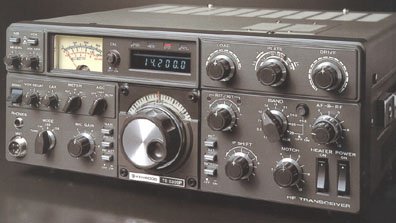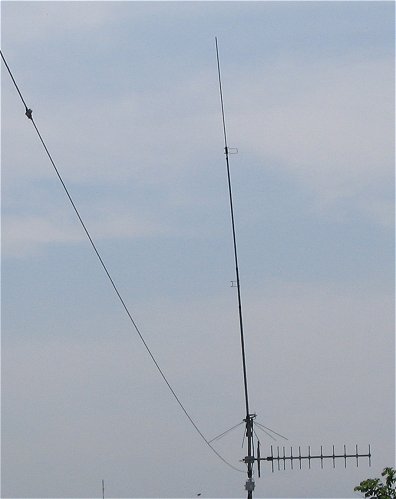|
Info
|
|
|
| U T C |
| STATION
Equipment
Today
The HF equipment I have been using since 2004 is a boatanchor Kenwood TS-530SP. It is an all-band transceiver (included WARC bands) manufactured in the mid of '80s. It is not a high technology but a state-of-art in its age. This is a basic CW/SSB transceiver with 3 tubes, one functions as a buffer amplifier and the other two are parallel power amplifiers. The advantage of these kind of rigs is the flexible antenna tuning capability. It is important for me because I have a limited antenna space so I am able to make use of the all band capability of the old lady.  The output power can be regulated up to 100W and that is more than enough to operate on HF bands. Unfortunately there is no IF CW filter hence I use a homebrew AF filter taking the signal from the variable volume control resistor. The bandwidth of the filter can be regulated from 10 Hz to 3 kHz and it has its own audio amplifier to provide AF output. I have microphone too, but that is very rare when used. For the sake of tests I also made some contacts in digi modes using direct connections to the computer. The output power should then be cut back to 25W otherwise the digi mode kills the tubes. All the way it does when the output is 25W or more continuously. CW 100W is the safe mode with correctly tuned antenna. By the way: The transceiver has a safe antenna tuning procedure. While tuning, the anode current can be set. I use 50 mA for tuning and refine with full power but only in seconds. The RIT/XIT control allows only +/- 2 kHz deviation seems to be a disadvantage but not for me. To operate in huge pile-ups is not my business. The antenna I have three antennas above the flat roof of a 5-storied building. The most used is the HF antenna that is a 21 mtrs long end-fed wire about 2 mtrs high above roof. This antenna is very flexible with my rig for it can be used for all 9 HF bands, but with a compromise especially on 80 and 160 m. It is matched with a 1 to 3 balun transformer (1:9 impedance transformation) which not really matches the end impedance of the wire. Despite it works and outstanding performance has been showed on 12, 15, 17, 20, 30 and 40 mtrs according to operation experience. On 10 mtr it works fair. The advantage of the mismatching is that the WARC bands are better matched due to the deviation of the resonant length of the wire. I have had altogether 229 DXCC countries worked (mainly in CW) for the time being since 2004.  I have also a collinear for 2 mtr and a fixed 11 element Yagi for 70 cm. The latter is fixed and was set to the direction of HG2RUB repeater (QTH Esztergom) far behind hills and mountains. I also have a fixed HB9CV for 2 mtr in a window. The VHF and UHF antennas were donated and mounted by Viktor, HA2QE the system operator of HG2RVD and HG2RUB repeaters linked to Echolink. The VHF 2 m equipment is a boatanchor Clegg FM-28 transceiver manufactured by Clegg Communications round 1977. This trx has an outstanding sensitivity and provides the best ISS reception of all rigs I have had. For 2 M and 70 cm FM there is a brand new UV-5R handheld with all accessories and computer programming capability to make use of all functions that this product offers. It seems that UV-5R tolerate outside antennas though my operation experience is very limited yet. |
| LINKS
HAMLOG - log search You have to log in to use or search. My log does not contain recent contest QSOs. SPAR Society for the Preservation of Amateur Radio is an international group activity to preserve ham radio for the future. Haros Radio Club The Club where I belong to (Hungarian mainly). HAmatőr Forum The most popular Hungarian ham forum for the time being (Hungarian) Contest Calendar (weekly) Actual contest information week by week. IARU The International Amateur Radio Union - The world organization of the amateur radio representation as ITU consultant. Hobby Rádió Online retro rádió, rádióamatőr témák is (Hungarian). |
CTC # 761 GACW # 802 CDX Member of SPAR